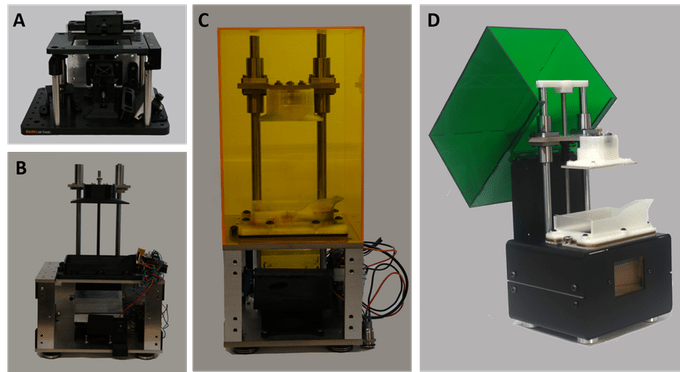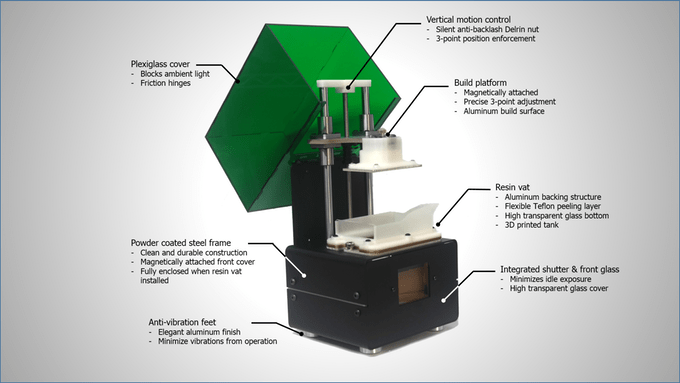
Here’s an intriguing new 3D printer: the MONO1 resin-based desktop unit.
The MONO1, by startup MonoPrinter, is developed by a group that originally focused on super-high resolution gear, but switched to a consumer-level device. They explain:
Mono1 is our first product of consumer 3D printers. We have been working on ultra-fine 3D patterning technology using femto-second lasers and expensive optical components. Even though the system can pattern 3 micron wide and high features, the system is too expensive to be readily available in the industry. Now we’re in the course of developing affordable ways to pattern high resolution 3D objects and Mono1 is the first consumer product in this development.
The machine is of the now-standard design for desktop resin machines: a DLP projector selectively illuminates photopolymer resin from the bottom through a transparent resin tank. The machine prints in layers and is not a member of the “super fast” resin printers we’ve seen recently. It does, however, have a special teflon film that should make the tank last longer.
But that’s OK, because the MONO1’s claim to fame isn’t super speed. No, it’s price. This machine is priced at what appears to be an appropriate price of between USD$1,799 for a fully assembled, projector-included model. The launch campaign also offers projector-less assemble-it-yourself configurations at early bird pricing as low as USD$749.
To me the early bird price is a distraction, as it’s the final price that really will matter. This product appears to be priced at a level that just may be able to support its development and production, unlike multiple low-ball offerings from others that have failed miserably when the bills are counted up. If it’s too cheap to believe, then it probably is. The MONO1 doesn’t seem to be at those price levels.
And it does seem to produce very good output. This example is a very complex print that’s only 47.7mm tall.

squid
The machine appears to be built with some attention paid to mechanical components, as those could determine the success rate of prints, at least according to the feature list.
The MONO1 comes with its own software system to prepare and drive prints, as is the case with virtually all other desktop 3D resin printers. The software appears to be for Windows, and it’s not clear whether versions exist for other platforms.
The build volume is not huge, as is usually the case for resin machines, and especially for budget equipment such as the MONO1. It’s build volume is 96 x 56 x 130 mm, and the company claims a build speed of around 25mm per hour, which is typical for this class of machine.
There is no requirement to use MonoPrinter resin in this machine, as it is completely open. This should reduce operating costs, but at the same may complicate operations as operators will have to determine by trial and error the best settings for each new material.

One of the most important aspects of this product is that it is supposedly finished, both hardware and software. They say the reason for the Kickstarter is simply to gain a quantity of orders to reduce manufacturing costs.
I believe this is a very important point suggesting this project could succeed, unlike other projects that publicly state they are still developing the product. In fact, MonoPrinter provides a number of videos of the machine printing high resolution objects.
At this price, it’s worth a look.
Via Kickstarter and MonoPrinter

